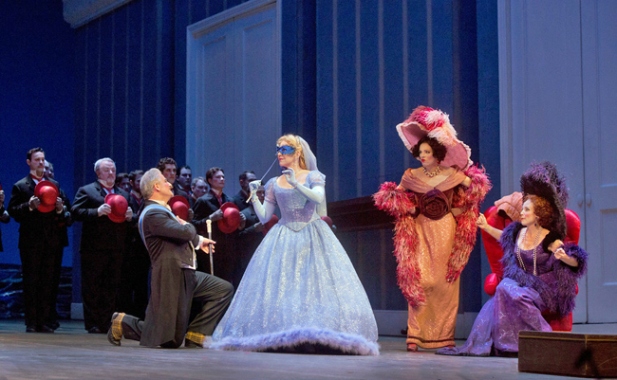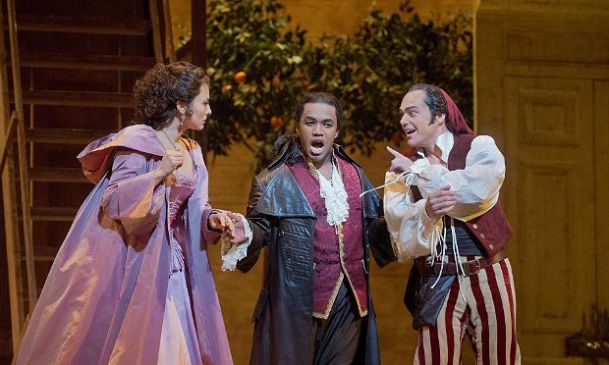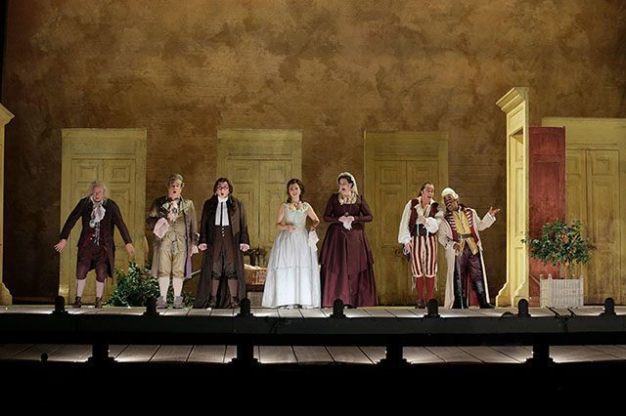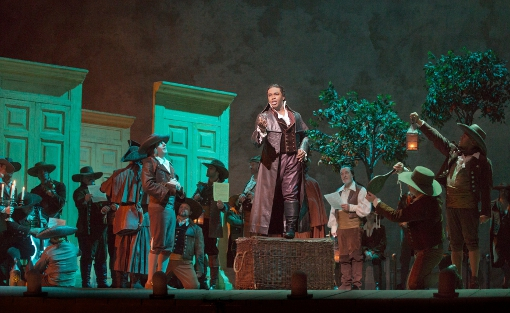
Screen capture of a performance of Verdi’s “Va, pensiero” chorus during the Met Opera’s At-Home Gala on April 25, 2020
Sing For Your Supper
When last we left the Metropolitan Opera, America’s premier repertory company had cancelled the remainder of its 2019-2020 season. As time went on and the circumstances under which the company thrived became ever grimmer, the Met’s general manager Peter Gelb was forced to reconsider the first half of their planned 2020-2021 season. Sadly, it too was withdrawn.
Having closed its doors in mid-March, due of course to the coronavirus outbreak, the Met Opera, along with its famed orchestra and chorus — and millions upon millions of radio listeners and live-streaming viewers the world over — were faced with the prospect of no opera performances at all and no work for all. This created a bind for singers, artists, stagehands, craftspeople, and anyone associated with the mechanics of bringing live opera to devotees of the form.
Similar to those in the movie and television industries, not to mention those in the dance and theater business, the bulk of opera’s participants are freelancers who depend on performing in order to meet their needs and obligations. Unlike essential workers, opera singers and chorus and orchestra members are considered non-essential personnel; consequently, they are at the mercy of theater companies for gainful employment. This situation has had a negative impact on performances worldwide.

General Manager Peter Gelb with Music Director Yannick Nezet-Seguin
Similarly, the sports community has also been stymied by the recurring presence of COVID-19. One possible solution, which has been tried in Europe and elsewhere, is to hold soccer matches in empty stadiums with prerecorded crowd noises and assorted cheers and shouts piped in. Another proposal involved placing dummy cutout figures around the field’s perimeter. This was done to give the “appearance” of a live audience in attendance. Can you imagine imposing such a solution to opera houses? The whole purpose of the art form is the immediacy of it. I can’t see this move as resolving anything. It fools no one and, ultimately, only calls attention to itself.
But the real questions on everybody’s minds are these: When will isolation be over? And when will things get back to normal? For most people, the issues are personal — and ergo more problematic. This holds true for HBO programs, and for Netflix, CBS-All Access, Amazon Prime, Disney+, and any number of channels and streaming services. How about sports and leisure-time activities: baseball, football, basketball, tennis, hockey, track and field, swimming, and others? When will their stadiums and arenas be filled to capacity again? That’s an unanswerable query at this point.
Granted, this is all wishful thinking on our part. We know that the problems of the world cannot be solved simply by holding the aforementioned activities. Too many people are suffering and dying at the moment for that to safely occur, what with the alarming upsurge in COVID-19 cases, both in the U.S. and in Latin and South America, having reached dire proportions.
More importantly, though, is the question of the continued viability for ALL the arts and the organizations that support them — from museums, art galleries, institutions of higher learning, Broadway, dance, and musical theater, to outdoor rock and pop concerts, poetry readings, lecture halls, indoor gatherings, and everything under the intellectual sun.
For those interested in any of the above pursuits, everyday life and the pleasures derived from them have ground to a halt. So speculating as to when and how these activities can safely resume is beyond the realm of possibility — at least, for the foreseeable future. Protecting ourselves and our loved ones should be, and is, the immediate concern. Driving the numbers down is of prime importance. Once control of the situation is achieved, then all these matters can be addressed.
Some issues will require immediate attention. Others will have to wait. However — and this is key — we must not allow complacency to govern our lives. People’s health and welfare are at stake. We must be as vigilant as ever in warding off this threat. We must all become displaced “artists” in our way, and in the time allotted to us.
If this is to be the new normal, then let it be so. To “sing for your supper” is to stand in someone else’s shoes. Only then will we be able to feel the pain and suffering that others have gone through. Only then will we be able to empathize with one another’s plight.
This is what it takes. The times demand it. Because this is what makes us whole and human.
From Live-Stream to At-Home With the Stars

Renee Fleming sings Verdi’s “Ave Maria” from ‘Otello’ from her home
The Met’s proposed solution to the dearth of opera performances was certainly the most unique endeavor the company has ever attempted. The “At-Home Gala,” as it was dubbed, took place live (for the most part) on Saturday, April 25 at 1 PM Eastern Standard Time. Forty or more individual artists partook of what can only be described as an unprecedented, globe-trotting live-stream event of immense value and import.
Not counting the many accompanists, technical crew, camera people, and sound engineers who participated, as well as the full Met Opera Orchestra and Chorus, there were live and prerecorded performances, across ten time zones(!), by the likes of Anna Netrebko, Renée Fleming, Roberto Alagna, Joyce DiDonato, Bryn Terfel, Jonas Kaufmann, Sonya Yoncheva, and many, many others. Fans got to see and hear their favorite artist in intimate surroundings. The immediacy of opera, downsized for home consumption, came through loud and clear.
One subject of note that should be mentioned: Each of the participants donated freely of their time and energy toward this event. All of the extracts reflected, in some way or another, an artist’s individual choice of a specific feeling, tone or mood. In addition, if listeners had any inkling of the historical significance of each piece, they would be able to identify what that particular artist’s personal statement was meant to convey, given the circumstances we find ourselves in.
Indeed, a collective sense of suffering and loss, sadness, joy, and exhilaration could be felt throughout the proceedings. The give-and-take that typically occurs in a stage production, or in a Live in HD broadcast, was magnified tenfold by the closeness of the live-stream process. Obviously, emotions ran high. Some artists were more subdued than others, given the wide range of nationalities presented. Some were introverts, possibly due to language barriers or inherent shyness; others displayed more outgoing behavior. Still others “let it all hang out,” as we Americans say, overflowing with sentiment or sorrow over whatever sensations they experienced through song.
Overall, each artist had something to say, whether implied or explicit. It is for us, the listener and viewer, to supply the missing ingredient — that is, of what lay behind and beyond the words and tunes. And for that, a knowledge of the pieces in question is paramount to understanding the underlying subtext. I’ll leave it to the individual viewer to do his or her homework on the matter.
Stepping up to the plate (you will forgive the sports analogy), Swedish baritone Peter Mattei, one of the tallest talents around, started things off with a delicately modulated depiction of Don Giovanni’s Serenade, “Deh, vieni alla finestra” (“Do come to the window”), accompanied by an accordion. Next, boundless energy took hold of tenor Roberto Alagna and his wife, Polish soprano Aleksandra Kurzak, in an extended excerpt from Donizetti’s L’Elisir d’Amore.

Aleksandra Kurzak looks on disapprovingly, as Roberto Alagna serenades her
The scene took place in Alagna’s living room, with a pianist providing the lively accompaniment. Alagna was in a boisterous mood, mugging and acting up a storm as the inebriated Nemorino. Running and jumping about like a grasshopper, he and Aleksandra chewed the scenery at every opportunity. It was both delightful and exhausting. As Peter Gelb told New York Times reporter Joshua Barone, “There’s no substitute for performing.” And that’s what we got: a live, in-your-face, and on-your-laptop opera experience.
In contrast, Georgian mezzo Anita Rashvelishvili’s lush version of “Mon coeur souvre à ta voix” (“My heart at your voice”) from Saint-Saëns’ Samson et Dalila lowered the room temperature by a few degrees. Following her, Michael Fabiano provided a subdued interpretation of Lensky’s melancholy air, “Kuda, kuda,” translated as “Where have you gone, those golden days of my spring?” The poet Lensky reflects on his life as he faces a duel to the death over a misunderstood slight. Still vocally impressive, retired Met diva Renée Fleming faithfully intoned Desdemona’s “Ave Maria” from Verdi’s Otello: “Pray for us sinners now and at the hour of our death,” she cried, as tears streamed down her cheeks.
After five live transmissions in a row, it was time for several prerecorded features, the first one being the achingly throbbing Intermezzo from Mascagni’s Cavalleria Rusticana, conducted by Met music director Yannick Nézet-Séguin in charge of the Met Opera Orchestra. Subsequently, mezzo-soprano Joyce DiDonato’s majestically poised and perfectly articulated “L’ombra mai fù” from Handel’s Serse, popularly known as the “Largo” and made famous by Enrico Caruso, made literal time stop. The performance was dedicated to the memory of Met violist Vincent Lionti, who had passed away of the coronavirus.

Joyce DiDonato, surrounded by strings, performing “L’Ombra mai fu” from Handel’s ‘Serse’
It was back to live action with tenor Jonas Kaufmann in an heroic account of Eléazar’s “Rachel, quand du Seigneur” from Halévy’s La Juive. This gave way to Italian baritone Ambrogio Maestri’s powerful “Nemico della patria” (“Enemy of the state”) from Giordano’s Andrea Chénier. Playing the piano was fellow paisan, conductor Marco Armiliato. By the way, chirpy coloratura Erin Morley accompanied herself in “Chacun le sait” (“Each one shall know”) from La Fille du Régiment by Donizetti. We were amazed at the number of talented instrumentalists among these superb voices. This showed that their careers could have gone in any number of directions. And Morley was no exception.
German baritone Michael Volle’s bronze-colored delivery of Wolfram’s “Song to the Evening Star” brought us closer to Paradise in one of dozens of vocal highlights. Elza van den Heever regaled listeners with a nostalgic Dutch folk song, “Heimwee” or “Homesick.” Another memorable moment was presented by tenor Matthew Polenzani, who also accompanied himself on the piano in “Londonderry Air,” also known as “Oh, Danny Boy.” Wistful and poignant, this deeply touching piece conveyed that unmistakable vibe of Irish sentimentality. His family members greeted him with vociferous applause. Concluding the segment, Latvian mezzo-soprano Elīna Garanča gave listeners a taste of her lusty Met Opera Carmen in the thrice familiar “Habañera.”
The second prerecorded performance of the day was of the Act III prelude to Wagner’s Lohengrin, led by Maestro Nézet-Séguin. After which, Welsh-born bass-baritone Bryn Terfel (a fine Wotan and Wanderer) and his harpist wife, Hannah Stone, gave an upbeat rendition of a favorite Welsh tune, made popular by gospel singer Mahalia Jackson, of “If I Can Help Somebody,” as appropriate-sounding a number as any.
Two back-to-back Verdi showstoppers, both from the Master’s Don Carlo, were rendered by powerhouse mezzo Jamie Barton (“O don fatale,” or “Oh fatal gift of my beauty”), who exhibited an infectiously bubbly personality, and Hawaiian-born baritone Quinn Kelsey (“Per me giunto,” or “For me, the supreme day is here”), in seamless fashion.

Mezzo Jamie Barton belts out Eboli’s aria “O don fatale”
This was followed by soprano Angel Blue, who made quite a splash this season in the new production of The Gershwins’ Porgy and Bess. She lived up to her name, revealing an absolutely gorgeous voice and poise in “Depuis le jour” (“After the day”) from Charpentier’s Louise, a once popular verismo potboiler not heard at the Met in many a season. German bass René Pape’s sepulchral tones and reverent approach to “In diesen heil’gen Hallen” (“In these hallowed halls”) from Mozart’s Die Zauberflöte, familiarly known as “The Magic Flute,” proved potent and closed this section.
Another prerecorded interlude featured Yannick Nézet-Séguin at the piano and Met concertmaster David Chan on solo violin, in the schmaltzy “Méditation” from Massenet’s exotic Thaïs. There followed notable contributions from Russian basso Ildar Abdrazakov in a lively Rachmaninoff song, Maltese tenor Joseph Calleja in a full-throated “Ah, lève-toi, soleil” (“Arise, thou loveliest sun”) from Gounod’s Roméo et Juliette, South African soprano Golda Schultz’s evocative delivery of Magda’s “Il bel sogno di Doretta” (“Doretta’s beautiful dream”) from Puccini’s La Rondine, North Carolina-born countertenor Anthony Roth Costanza’s mesmerizing “Pena tiranna” from Handel’s rarely heard Amadigi di Gaula, and stunning Bulgarian diva Sonya Yoncheva in the transcendent “Song to the Moon” from Dvořák’s Rusalka.
The concert’s musical peak and emotional highpoint, however, was reached with the stirring “Va, pensiero, sul ali dorate” (“Go, thought, on wings of gold”), or the “Chorus of the Hebrew Slaves,” from Verdi’s first great success Nabucco, sung to grandiloquent excellence by the Met Opera Chorus in a prerecorded segment that turned out to be a labor of love for all concerned. It is hard to capture in words the mixed feelings this piece engendered in the listener. One could only hum along with the composer’s sweeping three-quarter tempo. At the line, “O mia patria, si bella e perduta” – “Oh, my country, so beautiful and lost,” one couldn’t help turning our thoughts to those who have suffered at the devastation this plague has inflicted on humanity. The individual faces of the chorus and orchestra, conveying the sorrow of the lost children of Israel and their Babylonian captivity, were in truth revealing our own sorrow — no acting or role playing was required.

From top left: Angel Blue, Erin Morley, and Anita Rachvelishvili; and from bottom left: Javier Camarena, Jonas Kaufmann, Ailyn Perez and Solomon Howard
Next, listeners were treated to soprano Nadine Sierra in the perennial “Si, mi chiamano Mimì” from Puccini’s La Bohème; Polish wonder boy, tenor Piotr Beczala, provided an enthusiastic “Recondita armonia” from the same composer’s Tosca; a duet from Mozart’s Don Giovanni with soprano Diana Damrau and her husband Nicolas Testé (the ubiquitous “Là ci darem la mano”); high-flying sparks issued forth from Lawrence Brownlee’s throat (“A te, o cara,” from Bellini’s I Puritani); deep low-bass rumblings from Günther Groissböck (“Wie Schön” from Richard Strauss’s Die Schweigsame Frau) — a nice contrast here; and a prerecorded solo effort by Yusuf Eyvazov of Rodolfo’s “Che gelida manina,” also from La Bohème.
The last installment began with mezzo-soprano Isabel Leonard’s heartfelt and timely “Somewhere” (aka “There’s a Place for Us”) from Bernstein-Sondheim-Robbins’ West Side Story. The New York City native was nearly overcome with emotion, so pertinent were the song’s lyrics (“We’ll find a new way of living / We’ll find a way of forgiving”) to our own time and place.
Soprano Ailyn Perez and bass Solomon Howard, as Luisa and Wurm, provided a scorching duet from Verdi’s Luisa Miller; Lisette Oropesa wiped the coloratura slate clean with a remarkably apt “En vain, j’espère” (“In vain, I hope”), from Meyerbeer’s Robert le Diable; Nicole Car and Etienne Dupuis performed “Baigne deux,” again from Thaïs; Stephen Costello and his wife, violinist Yoon Kwon Costello, gave us “Salut demeure” from Gounod’s Faust; and an incredible display of agility and breath control came from Mexican tenor Javier Camarena in a bravura aria and cabaletta from Bellini’s Il Pirata, a taste of what’s waiting in the wings for 2021.

Soprano Anna Netrebko performing a Rachmaninoff song
And finally, an established individual who merits a paragraph of her own: Russian prima donna Anna Netrebko, in a standout, viscerally charged sequence recorded in Vienna of the Rachmaninoff song, “Oh, never sing to me again!”
We pray that sentiment may never come to pass.
In sum, this marvelous concert stood as a metaphor for our collective suffering and unity of purpose. Yes, we are separated from our friends, family, and loved ones. Yes, the world is spinning out of our control. But together, we commiserate; together we struggle; together we overcome. And together, we contribute. Even if we are physically apart, even if we are separated by great distances, we will stand as one. Our voices will not be silenced. We will be heard, either alone or as a unit. Let them ring out loudly and for all.
This is the message of the Met’s virtual “At-Home Gala.”
Copyright © 2020 by Josmar F. Lopes












You must be logged in to post a comment.